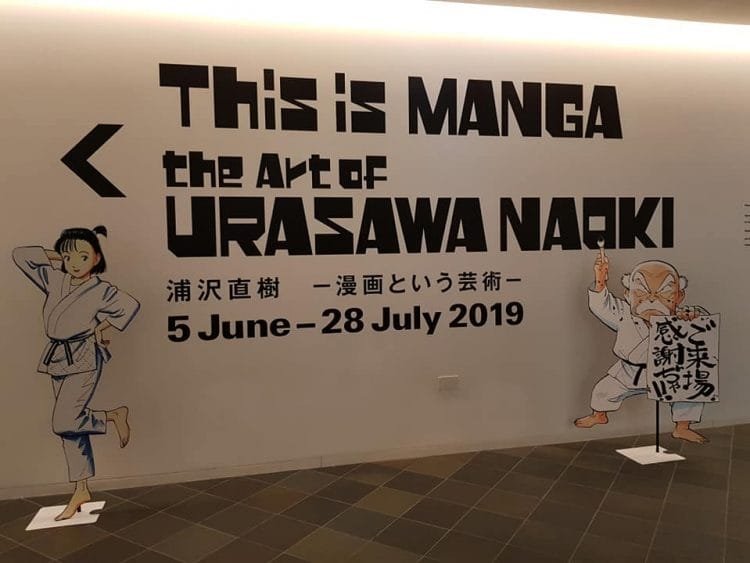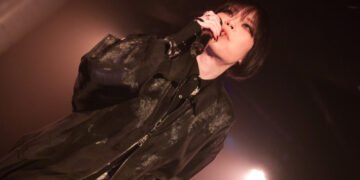London is lucky enough to be hosting not 1, but 2 manga exhibitions as part of the Japan-UK Season of Culture 2019-2020. Both are relatively close to each other thanks to the London Underground, so it is perfect to make it into a day trip to visit both.
Starting the day at the This is Manga – the Art of Urasawa Naoki exhibition in the Japan House. As you can guess from the title it focuses on Urasawa Naoki, an established manga artist and the creator of series such as 20th Century Boys, Monster, etc. The exhibition itself is in the hall downstairs, down a small hallway which literally just has a picture of a girl on the wall, which is kind of creepy but the staff laughed with us about it. Where the hall itself left as a relatively open space (with a cool installation feature in the middle), it has little sections dedicated to particularly series Urasawa was involved in, giving you not only an overview and particular art techniques to notice, but also the original storyboards of the work for your viewing pleasure.

For a free exhibition, there was a lot there which made it really impressive. It was very informative and seeing the original storyboards was incredible as you could see all the little pencil and pen strokes that led to the final outcome. This was even more enhanced by the fact dotted around on the walls there were original drawings by Urasawa for the exhibit itself. These vary from little sketches on the wall to framed fully completed illustrations. Overall it was a real eye-opener to the efforts behind the printed works that do get lost a bit in the printed copies, making you appreciate the original sketches for the pages to create the various effects.

Then a tube ride across London to the British Museum for the Manga Exhibit there. For me, it was cool enough the British Museum was hosting this in one of their exhibition rooms. Compared to the other exhibit, this was a lot more general view on manga and was split into three sections. The first section you start in focuses on making manga and the history of manga, the second was a mini-manga library, and the last was discussing different genres and themes of manga.

So let’s focus on the first section of the exhibit. The history part was done really well, highlighting key Japanese historical artefacts are thought to of started manga in its form today, but also Western things such as the Disney comics which also helped bring in new ideas. Not only that, it highlights key series and artists that helped develop the profile of manga in the last decade, showing off the original storyboards from their most prolific works. For me, the fact Akatsuka Fujio (creator of Osomatsu-Kun, Genius Bakabon, etc.) was featured in this was great, as he has such an influence in Japanese culture but is not well known in the west. This will really help bridge that gap, and hopefully, build up his profile over here. His daughter, Akatsuka Rieko, also created a sculpture based on sound effects her father used in his work which is also really cool.

Then you find yourself in the middle, where there is a manga library, featuring a mixture of series sporadically in Japanese, English and some other languages. What was particularly cool was they had copies of various manga magazines from Japan to truly showcase the difference to those unaware. If you’re in no rush, it’s a great chance to have a look at a series you’ve been meaning to start, or like me trying to find your favourite series printed in Weekly Shonen Jump…
After you have given up trying to find your favourite series, the last section focuses on different genres and themes of manga. Similar to the other exhibition, each has a cool description of this, although the display was more focused on showing the storyboard for the series itself making it a bit disjointed. A prime example of this, was Yo-Kai Watch was featured in Horror, not fully describing the twist on Yo-Kai for a child audience. Where I will criticise it on that front, it is still cool seeing a range of original storyboards, particularly from the big series such as Attack on Titan, One Piece, Naruto, etc. Not only that, it showcased the different mediums manga has then been adapted to, such as anime but also a cool section on the manga forms of Pokémon media, and also events such as Comiket!

Still I left wishing some other series was featured, particularly as there was a big print of a One Punch Man panel hanging from the ceiling but it wasn’t in the exhibit. Considering it originates as a web-comic, it would have been great to have a focus on it to point to the future. In-fact there was no real focus on how manga is made over that a small bit at the beginning which was disappointing. It felt more of a case that they were showing off the original storyboards and made the exhibit over the ones they had. Where I do understand this, at the same time the exhibit could have been put together better. Not only that, I think a small feature on Radient, a French series heavily inspired by manga, would have been great to show the impact across the world. Particularly as it was made into an anime, showing the manga style’s influence across the globe.

Sure there are some criticisms here but honestly, I would say if you are a big manga fan and want to know more this is still worth the visit. If you are in London, I would recommend you make the trip to visit both of these exhibits while you have the chance. The This is MANGA – the Art of URASAWA NAOKI exhibition will be at the Japan House London until 28th July (which has free entry). The Manga Exhibit is at British Museum until 26th August (Adult Tickets £19.50, 16-18 Years Old £16.00, Under 16 Free, Student, Disabled, and other discounts available). Where it is recommended to buy in advance, it is possible to buy tickets on the day.
Photography: AlexD





















